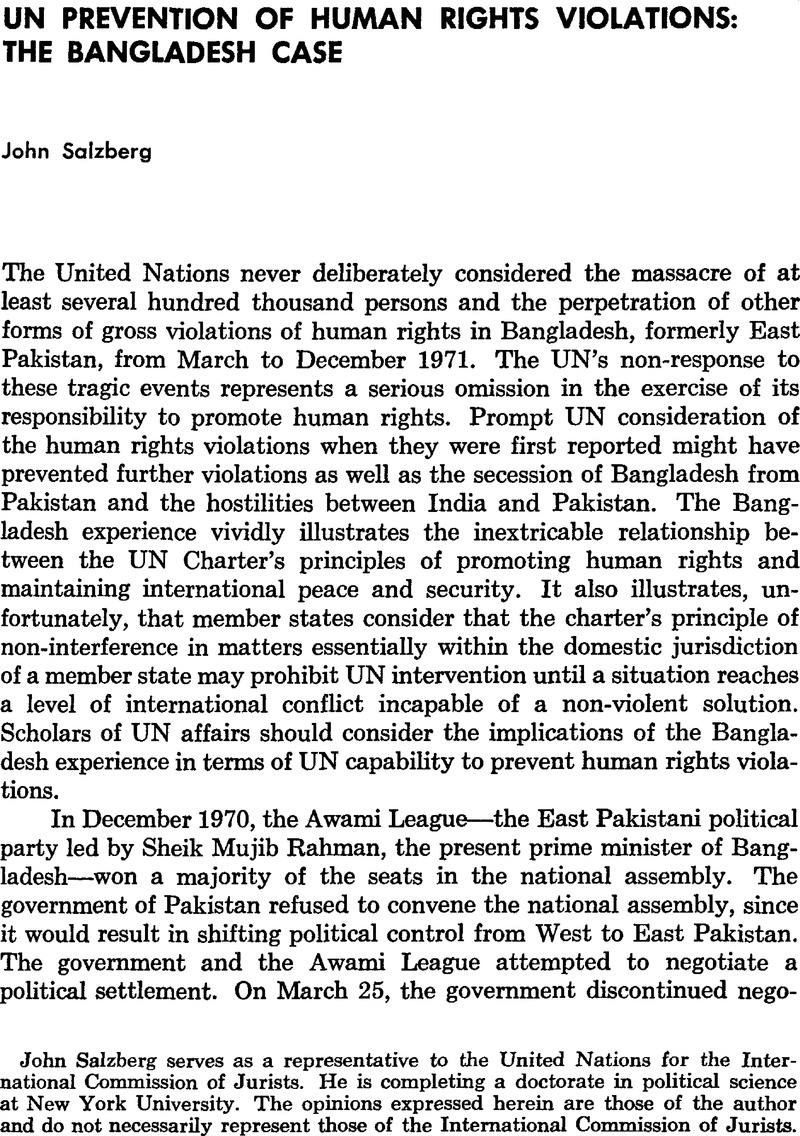Published online by Cambridge University Press: 22 May 2009

1 The following citations are a selective listing of eyewitness accounts of atrocities:
Mascarenhas, Anthony, “Genocide,” The Sunday Times (London), 06 13, 1971.Google Scholar
Schanberg, Sydney H., “Hindus Are Targets of Army Terror in an East Pakistani Town,” New York Times, Sunday, 07 4, 1971.Google Scholar
Szulc, Tad, “World Bank Unit Says Pakistan Aid Is Pointless Now,” New York Times, Tuesday, 07 13, 1971, p. 1, col. 1.Google Scholar
Schanberg, Sydney H., “West Pakistan Pursues Subjugation of Bengalis,” New York Times, Wednesday, 07 14, 1971, p. 1, col. 3.Google Scholar
Kann, Peter R., “A Nation Divided,” Wall Street Journal, Friday, 07 23, and Monday, 07 27, 1971.Google Scholar
Report of the International Rescue Committee's Emergency Mission to India for Pakistan Refugees (International Rescue Committee, Inc., New York: 07 24, 1971).Google Scholar
Singh, Khushwant, “Why They Fled Pakistan—And Won’t Go Back,” New York Times Magazine, 08 1, 1971, Section 6, p. 12.Google Scholar
Agarwala, Prabhu Dayal, “East Pakistan: The Goondas of Saidpur,” New York Times, Thursday, 08 19, 1971, p. 35.Google Scholar
Schanberg, Sydney H., “Bengali Refugees Say Soldiers Continue to Kill, Loot and Burn, New York Times, 09 22, 1971, p. 1, col. 2.Google Scholar
Browne, Malcolm W., “Horrors of East Pakistan Turning Hope into Despair,” New York Times, 10 11, 1971, p. 1, col. 2.Google Scholar
2 In addition, the Economic and Social Council Resolution 1503 (XLVIII) of May 27, 1970 established procedures for reviewing communications sent by individuals and groups alleging the violation of human rights. These procedures, however, were not operative during the Bangladesh crisis. See note 34.
3 The Commission on Human Rights did not meet during the Bangladesh crisis.
4 ECOSOC Resolution 1296 (XLIV), May 23, 1968.
5 E/CN.4/Sub.2/NG0.46, July 23, 1971, operative paras. 2 and 3. The following NGO's signed the statement:
Catholic International Education Office
Coordinating Board of Jewish Organizations
Friends World Committee for Consultation
International Association for Religious Freedom
International Catholic Child Bureau
International Catholic Union of the Press
International Commission of Jurists
International Council of Jewish Women
International Federation for the Rights of Man
International Federation of Women Lawyers
International Humanist and Ethical Union
International League for the Rights of Man
International Student Movement for the UN
Pan Pacific and Southeast Asia Women's Association
Pax Romana (International Catholic Movement for Intellectuals and Cultural Affairs)
World Association of World Federalists
World Jewish Congress
Women's International League for Peace and Freedom
World Student Christian Federation
World Union of Catholic Women's Organizations
World University Service
World's Woman's Christian Temperance Union.
6 E/CN.4/Sub.2/SR.629, August 16, 1971, pp. 75–79.
7 E/CN.4/Sub.2/SR.633, August 18, 1971, pp. 139–144.
8 ibid., pp. 145–146. India did not have a member on the sub–commission and, therefore, was permitted to speak as an observer state.
9 In drafting the report to the Commission on Human Rights, one member (Adamu Mohammed of Nigeria) even proposed deleting any reference to the discussion on East Pakistan. He argued that the sub–commission had listened to, but not considered, the statements made by the representative of the International Commission of Jurists, the member from Pakistan and the observer for India. Fortunately, his proposal was defeated. E/CN.4/Sub.2/SR.635, August 20, 1971, pp. 166–170.
10 E/CN.4/Sub.2/SR.629, August 16, 1971, pp. 74–75.
11 Article 1, paragraph 1. See United Nations, Treaty Series, vol. 669, p. 195Google Scholar, Registration No. 9464; the Convention also appears in the UN document entitled “Human Rights: A Compilation of International Instruments of the United Nations,” Sales No. E.68.XIV.6 (A/CONF.32/4), 1967, p. 23.Google Scholar
12 Articles 8 and 9.
13 Article 11. Under Article 14, states parties may elect to permit complaints by individuals and groups. This article is presently not in effect since fewer than ten states have consented to individual complaints.
14 General Assembly Official Records, 26th Sess., 1971, Suppl. No. 18 (A/8418), p. 8.Google Scholar
15 ibid.
16 ibid., pp. 9–11.
17 UN Press Release SG/SM 1516, Aug. 2, 1971; and S/10410, Dec. 3, 1971, pp. 3–4.
18 The Security Council debates are contained in S/PV.1606–PV.1614 and Add.1, PV.1615–PV.1617, and PV.1621, Dec. 4–21, 1971.
19 S/PV.1606, Dec. 4, 1971, pp. 171–172; S/PV.1607, Dec. 5, 1971, pp. 126–127; S/PV.1613, Dec. 13, 1971, pp. 118–120.
20 S/PV.1607, Dec. 5, 1971, p. 117.
21 S/PV.1606, Dec. 4, 1971, p. 133–135.
22 ibid., pp. 127, 128–130.
23 ibid., p. 51.
24 General Assembly Resolution 377 A (V) adopted on November 3, 1950, provides that when the permanent members of the Security Council lack unanimity a situation may be referred to the General Assembly.
25 General Assembly Resolution 2793 (XXVI), Dec. 7, 1971.
26 Security Council Resolution 307 (1971), Dec. 21, 1971.
27 Economic and Social Council Official Records, 4th Sess., 1947, Suppl. No. 3 (E/259), p. 5.Google Scholar
28 Article 8(1). See note 11 supra.
29 A/PV.2003, Dec. 7, 1971, p. 11.
30 ibid., p. 57.
31 E/CN.4/SR.1180, Apr. 5, 1972, p. 3.
32 ibid.
33 ibid., p. 5.
34 Economic and Social Council Resolution 1503 (XLVIII), May 27, 1970.
35 General Assembly Resolution 2841 (XXVI), Dec. 18, 1971.
36 A/C.3/L.1851, Oct. 8, 1971, para. (1).
37 Italics added. General Assembly Official Records, 26th Sess., Suppl. 1A (A/8401/Add.l), paras. 146–147.